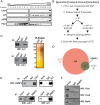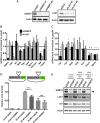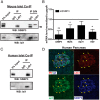SSBP3 Interacts With Islet-1 and Ldb1 to Impact Pancreatic β-Cell Target Genes
- PMID: 26495868
- PMCID: PMC4664226
- DOI: 10.1210/me.2015-1165
SSBP3 Interacts With Islet-1 and Ldb1 to Impact Pancreatic β-Cell Target Genes
Abstract
Islet-1 (Isl1) is a Lin11, Isl1, Mec3 (LIM)-homeodomain transcription factor important for pancreatic islet cell development, maturation, and function, which largely requires interaction with the LIM domain-binding protein 1 (Ldb1) coregulator. In other tissues, Ldb1 and Isl1 interact with additional factors to mediate target gene transcription, yet few protein partners are known in β-cells. Therefore, we hypothesize that Ldb1 and Isl1 participate in larger regulatory complexes to impact β-cell gene expression. To test this, we used cross-linked immunoprecipitation and mass spectrometry to identify interacting proteins from mouse β-cells. Proteomic datasets revealed numerous interacting candidates, including a member of the single-stranded DNA-binding protein (SSBP) coregulator family, SSBP3. SSBPs potentiate LIM transcription factor complex activity and stability in other tissues. However, nothing was known of SSBP3 interaction, expression, or activity in β-cells. Our analyses confirmed that SSBP3 interacts with Ldb1 and Isl1 in β-cell lines and in mouse and human islets and demonstrated SSBP3 coexpression with Ldb1 and Isl1 pancreas tissue. Furthermore, β-cell line SSBP3 knockdown imparted mRNA deficiencies similar to those observed upon Ldb1 reduction in vitro or in vivo. This appears to be (at least) due to SSBP3 occupancy of known Ldb1-Isl1 target promoters, including MafA and Glp1r. This study collectively demonstrates that SSBP3 is a critical component of Ldb1-Isl1 regulatory complexes, required for expression of critical β-cell target genes.
Figures





Similar articles
-
The islet-expressed Lhx1 transcription factor interacts with Islet-1 and contributes to glucose homeostasis.Am J Physiol Endocrinol Metab. 2019 Mar 1;316(3):E397-E409. doi: 10.1152/ajpendo.00235.2018. Epub 2019 Jan 8. Am J Physiol Endocrinol Metab. 2019. PMID: 30620636 Free PMC article.
-
The SSBP3 co-regulator is required for glucose homeostasis, pancreatic islet architecture, and beta-cell identity.Mol Metab. 2023 Oct;76:101785. doi: 10.1016/j.molmet.2023.101785. Epub 2023 Aug 1. Mol Metab. 2023. PMID: 37536498 Free PMC article.
-
Islet α-, β-, and δ-cell development is controlled by the Ldb1 coregulator, acting primarily with the islet-1 transcription factor.Diabetes. 2013 Mar;62(3):875-86. doi: 10.2337/db12-0952. Epub 2012 Nov 27. Diabetes. 2013. PMID: 23193182 Free PMC article.
-
LIM-domain-binding protein 1: a multifunctional cofactor that interacts with diverse proteins.EMBO Rep. 2003 Dec;4(12):1132-7. doi: 10.1038/sj.embor.7400030. EMBO Rep. 2003. PMID: 14647207 Free PMC article. Review.
-
Enhancer long-range contacts: The multi-adaptor protein LDB1 is the tie that binds.Biochim Biophys Acta Gene Regul Mech. 2019 Jun;1862(6):625-633. doi: 10.1016/j.bbagrm.2019.04.003. Epub 2019 Apr 22. Biochim Biophys Acta Gene Regul Mech. 2019. PMID: 31022553 Review.
Cited by
-
The Contribution of Transcriptional Coregulators in the Maintenance of β-cell Function and Identity.Endocrinology. 2021 Feb 1;162(2):bqaa213. doi: 10.1210/endocr/bqaa213. Endocrinology. 2021. PMID: 33211800 Free PMC article. Review.
-
The multi-lineage transcription factor ISL1 controls cardiomyocyte cell fate through interaction with NKX2.5.Stem Cell Reports. 2023 Nov 14;18(11):2138-2153. doi: 10.1016/j.stemcr.2023.09.014. Epub 2023 Oct 19. Stem Cell Reports. 2023. PMID: 37863045 Free PMC article.
-
The islet-expressed Lhx1 transcription factor interacts with Islet-1 and contributes to glucose homeostasis.Am J Physiol Endocrinol Metab. 2019 Mar 1;316(3):E397-E409. doi: 10.1152/ajpendo.00235.2018. Epub 2019 Jan 8. Am J Physiol Endocrinol Metab. 2019. PMID: 30620636 Free PMC article.
-
Alpha TC1 and Beta-TC-6 genomic profiling uncovers both shared and distinct transcriptional regulatory features with their primary islet counterparts.Sci Rep. 2017 Sep 20;7(1):11959. doi: 10.1038/s41598-017-12335-1. Sci Rep. 2017. PMID: 28931935 Free PMC article.
-
LIM domain-binding 1 maintains the terminally differentiated state of pancreatic β cells.J Clin Invest. 2017 Jan 3;127(1):215-229. doi: 10.1172/JCI88016. Epub 2016 Dec 12. J Clin Invest. 2017. PMID: 27941246 Free PMC article.
References
-
- Pan FC, Wright C. Pancreas organogenesis: from bud to plexus to gland. Dev Dyn. 2011;240:530–565. - PubMed
-
- Shih HP, Wang A, Sander M. Pancreas organogenesis: from lineage determination to morphogenesis. Annu Rev Cell Dev Biol. 2013;29:81–105. - PubMed
-
- Thor S, Ericson J, Brännström T, Edlund T. The homeodomain LIM protein Isl-1 is expressed in subsets of neurons and endocrine cells in the adult rat. Neuron. 1991;7:881–889. - PubMed
Publication types
MeSH terms
Substances
Grants and funding
LinkOut - more resources
Full Text Sources
Other Literature Sources
Molecular Biology Databases
Research Materials
Miscellaneous

